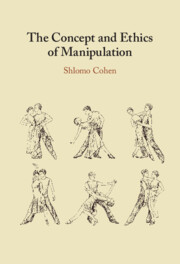Chapter 1 - An Elusive Concept
from Part I - The Concept
Published online by Cambridge University Press: 10 April 2025
Summary
Manipulation is pervasive in our lives, yet it is not well understood. Specifically, we lack a wide philosophical theory of manipulation. Such a theory will successfully answer two main questions: a question about the precise meaning of “manipulation,” and a question about its moral status. Prior to presenting a novel theory of manipulation in the following chapters, Chapter 1 offers an overview of the state of the art of philosophical thinking on manipulation. The semantic field of manipulation is constructed by three main concepts: rational persuasion, deception, and coercion. Manipulation cannot, however, be understood adequately on the basis of any one of these concepts, and there is no good theory that accounts for manipulation using a combination of them. The chapter reviews the many difficulties left open by notable attempts to provide an account of the concept of manipulation. The criticisms of those attempts raise the deeper suspicion that perhaps manipulation is not to be captured by a definition at all.
Information
- Type
- Chapter
- Information
- The Concept and Ethics of Manipulation , pp. 3 - 41Publisher: Cambridge University PressPrint publication year: 2025
